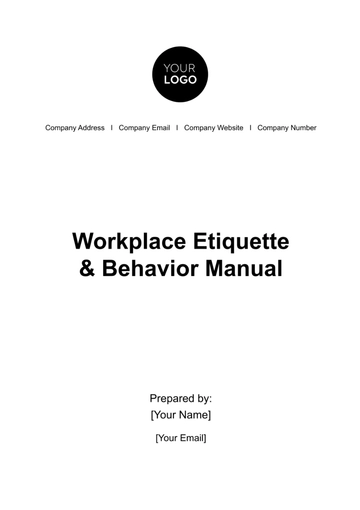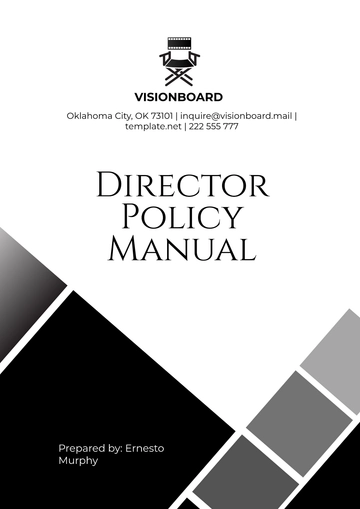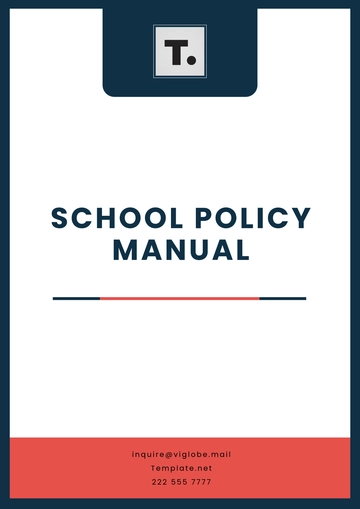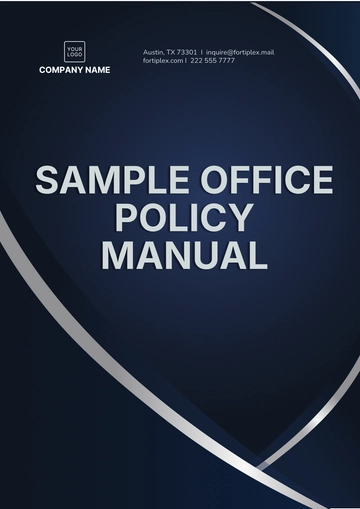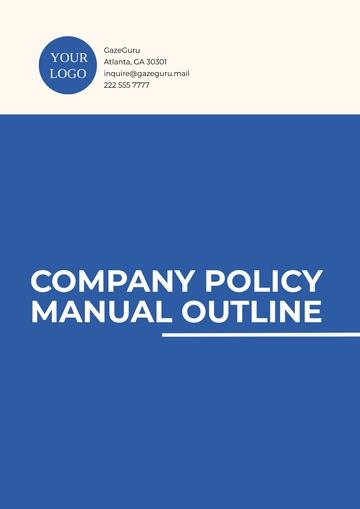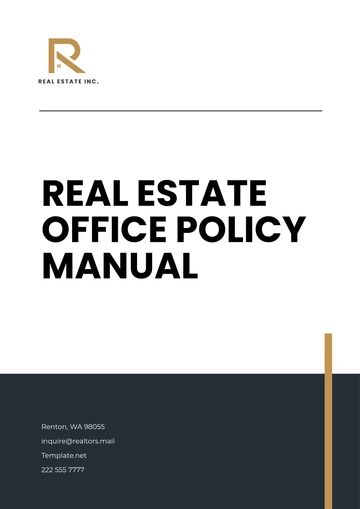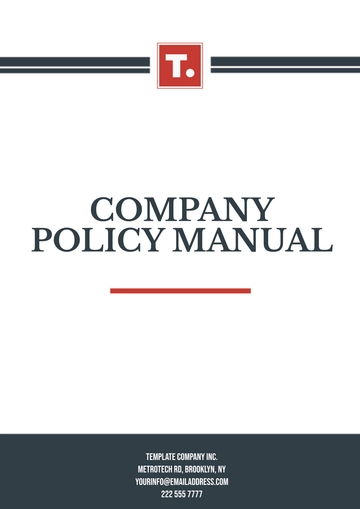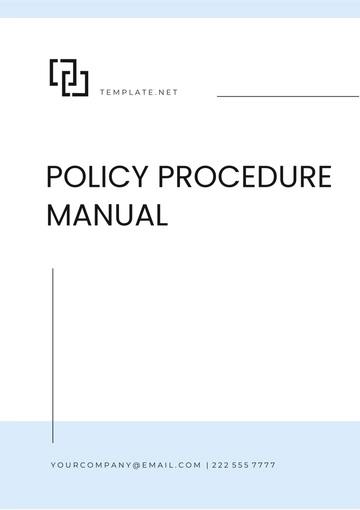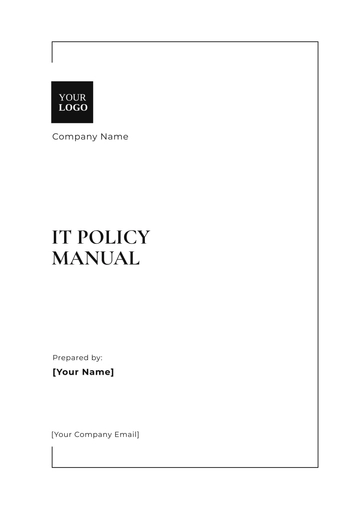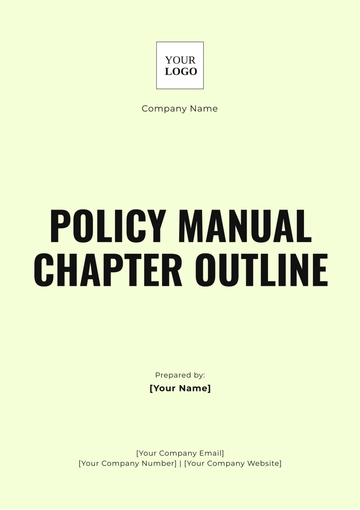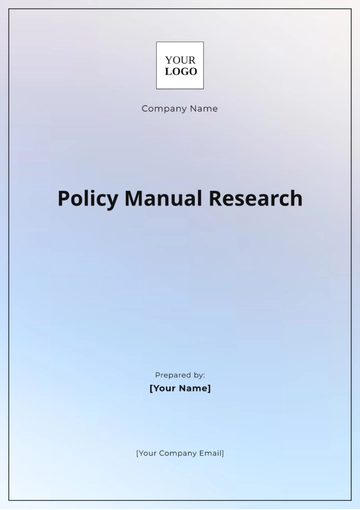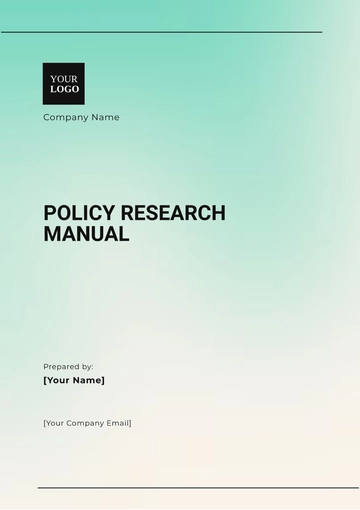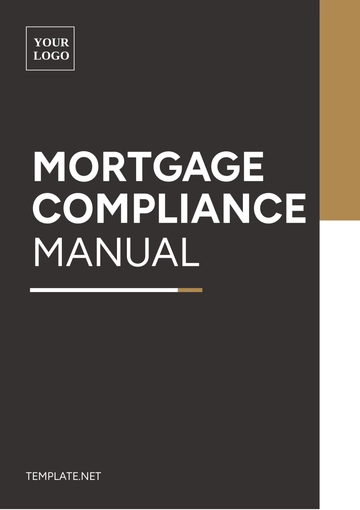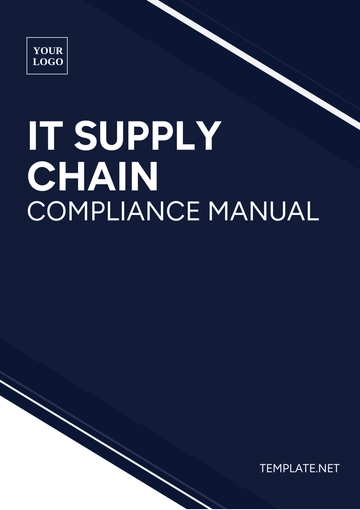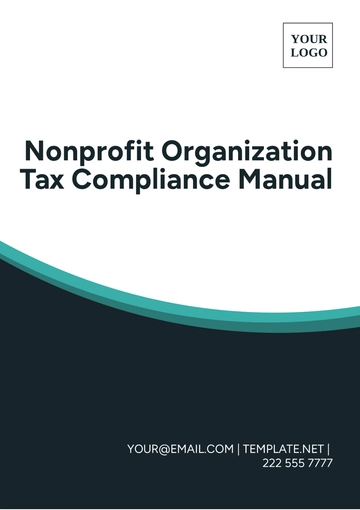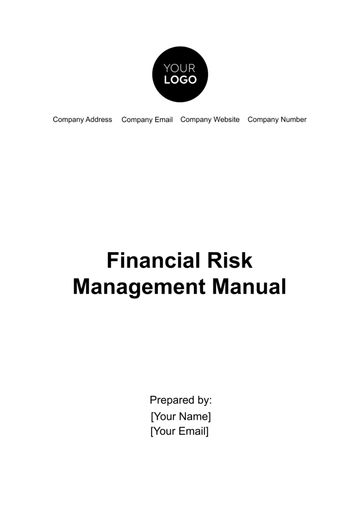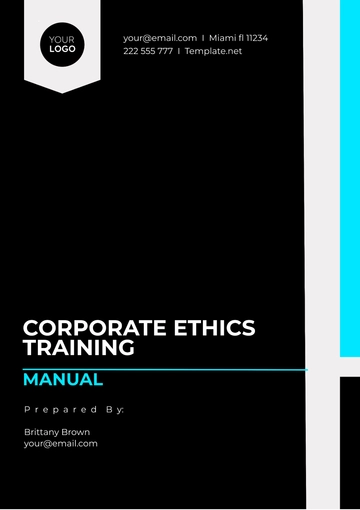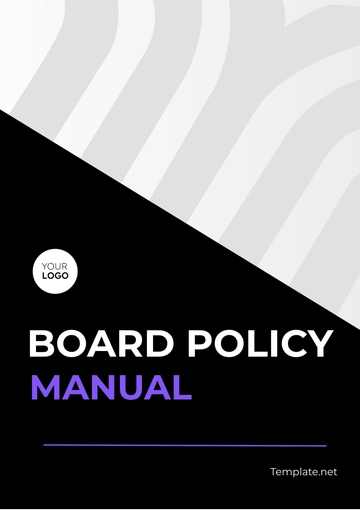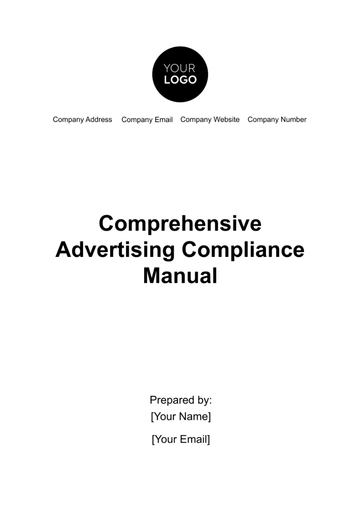Free Financial Risk Management Manual
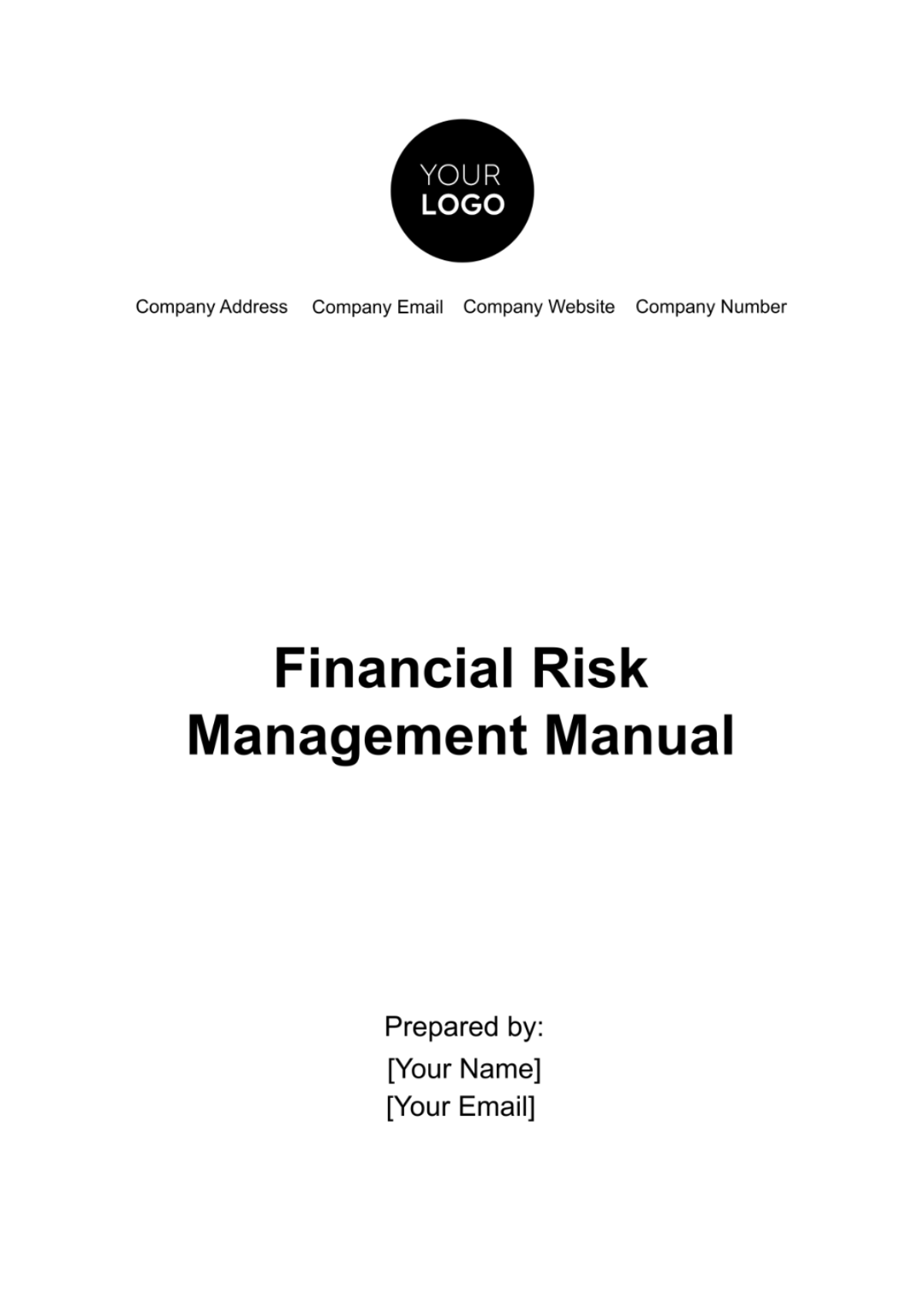
Introduction |
This Financial Risk Management Manual is designed as a comprehensive guide to managing the diverse range of financial risks our organization may face in the dynamic global market. It serves as a key resource for understanding, identifying, and addressing financial risks effectively and systematically. The manual provides detailed processes and procedures, aiming to embed risk management into the fabric of our organizational practices and decision-making processes.
Objectives
1. Risk Identification: To systematically and proactively identify potential financial risks that could impact our operations, including market, credit, liquidity, and operational risks.
2. Risk Analysis and Assessment: To accurately assess and analyze the identified risks, quantifying their potential impact and determining the likelihood of their occurrence.
3. Risk Mitigation and Control: To develop and implement effective strategies and controls to mitigate identified risks, minimizing potential adverse impacts on our financial health and objectives.
4. Continuous Monitoring and Reporting: To establish ongoing monitoring mechanisms for risks, ensuring that they are continuously managed, and to report risk status effectively to relevant stakeholders.
5. Compliance and Governance: To ensure that our risk management practices comply with regulatory requirements and align with best practices in corporate governance.
6. Culture of Risk Awareness: To foster a culture of risk awareness and informed decision-making throughout the organization.
Scope of the Manual
The scope of this manual encompasses the entire spectrum of financial risk management activities within our organization. It covers:
The fundamental principles and frameworks of risk management.
Specific processes and techniques for identifying, assessing, mitigating, monitoring, and reporting financial risks.
The roles and responsibilities of different stakeholders in the risk management process.
This manual is intended for use by all levels of staff involved in financial decision-making, risk management, and compliance functions, ensuring a consistent and comprehensive approach to financial risk management across our organization.
Risk Management Framework |
Our framework provides a structured and disciplined approach to managing financial risks, ensuring that risk management is an integral part of our organizational strategy and decision-making processes. It aligns risk management practices with our overall business objectives, enabling us to manage risks proactively and effectively.
Description of Approach
Our approach to risk management is based on a comprehensive understanding of the various financial risks that may impact our operations. It involves:
1. Integrated Risk Management: Incorporating risk management into all aspects of our business activities and decision-making processes.
2. Proactive Risk Identification: Continuously identifying potential risks through a variety of methods, including market analysis, trend monitoring, and scenario planning.
3. Quantitative and Qualitative Risk Assessment: Employing both qualitative and quantitative methods to assess and prioritize risks based on their potential impact and likelihood.
4. Strategic Risk Mitigation: Developing and implementing targeted strategies to mitigate identified risks, including risk transfer, avoidance, reduction, or acceptance.
Roles and Reponsibilities
Board of Directors | Oversee the risk management framework, set risk appetite. |
Risk Management Committee | Develop and implement risk management policies/strategies. |
Chief Risk Officer (CRO) | Lead the risk management function. |
Department Heads | Identify and manage risks within their respective areas. |
Finance Team | Conduct financial risk analysis, support risk mitigation. |
Compliance Officer | Ensure regulatory compliance, monitor legal risk aspects. |
IT Department | Manage cybersecurity and technology-related risks. |
Risk Identification |
Risk identification is a critical first step in our financial risk management process, involving the systematic detection of potential risks that could adversely affect our financial objectives and operations. This section outlines the various methods and tools we employ to identify different types of financial risks, ensuring a comprehensive approach to risk management.
Identification Methods
Type of Risk | Method of Identification |
Market | Analysis of market trends, economic indicators, and market volatility. |
Credit | Review of credit histories, ratings, and counterparty exposures. |
Liquidity | Monitoring cash flow forecasts and liquidity ratios. |
Operational | Assessment of internal processes, systems, and external events. |
Legal/Compliance | Keeping abreast of regulatory changes and legal developments. |
Strategic | Strategic planning sessions and industry analysis. |
Reputational | Media monitoring and stakeholder feedback analysis. |
Cybersecurity | IT system audits and vulnerability assessments. |
Tools and Techniques
A. Financial Modeling and Analysis: To simulate various financial scenarios and assess potential impacts.
B. Risk Assessment Checklists: To systematically identify risks in different areas of operations.
C. Data Analytics and Big Data Tools: For analyzing large volumes of financial data to identify trends and risks.
D. SWOT Analysis: To assess strengths, weaknesses, opportunities, and threats related to financial aspects.
E. Scenario Planning: To anticipate potential future risks under different scenarios.
F. Internal and External Audits: To uncover hidden risks and ensure compliance with financial standards.
Risk Assessment and Analysis |
The assessment and analysis of identified risks are crucial for understanding their potential impact on our financial stability and for formulating effective mitigation strategies. In this section, we outline the various techniques and models employed to assess, quantify, and prioritize risks, ensuring a detailed and accurate understanding of our risk profile.
Techniques
A. Quantitative Analysis: Utilizing statistical methods to quantify risk exposure, such as potential loss amounts and probabilities of occurrence.
B. Qualitative Analysis: Assessing risks based on expert judgment, industry experience, and qualitative factors that might influence the risk.
C. Historical Analysis: Reviewing past incidents and trends to estimate the likelihood and impact of similar risks in the future.
D. Comparative Analysis: Comparing risks against industry benchmarks or peer organizations to gauge relative risk levels.
Models and Tools
A. Value at Risk (VaR): This model estimates the maximum potential loss over a specified time period at a given confidence interval, commonly used for market and credit risk.
B. Stress Testing: Simulating various extreme but plausible adverse conditions (such as economic downturns) to understand potential risk impacts.
C. Sensitivity Analysis: Assessing how changes in underlying assumptions (like interest rate changes) impact our risk exposure.
D. Monte Carlo Simulations: Using computerized mathematical techniques to model and assess the probability of different outcomes in a process that cannot easily be predicted.
Criteria for Determining Risk Significance
Financial Impact | Potential loss amount or financial consequence of the risk. |
Likelihood of Occurrence | Probability of the risk event happening. |
Speed of Onset | How quickly a risk can impact the organization. |
Duration of Impact | How long the effects of the risk are expected to last. |
Controllability | The degree to which the risk can be controlled or influenced. |
Risk Mitigation Strategies |
Effective risk mitigation is crucial for managing and minimizing the potential impacts of financial risks on our organization. This section outlines the various approaches we take to mitigate risks, along with specific strategies tailored for different types of financial risks, and provides guidelines for selecting the most appropriate tools and techniques for each situation.
Approaches to Risk Mitigation
Eliminating the risk entirely by not engaging in activities that generate the risk.
Implementing measures to reduce the likelihood or impact of the risk.
Shifting the risk to another party, such as through insurance or contractual agreements.
Acknowledging the risk and choosing to retain it, often due to low impact or cost of mitigation exceeding the potential loss.
Specific Strategies
Type of Risk | Mitigation Strategy |
Market | Use of hedging instruments, diversification of investment portfolio. |
Credit | Performing rigorous credit assessments, requiring collateral. |
Liquidity | Maintaining sufficient cash reserves, managing assets and liabilities. |
Operational | Implementing robust internal controls and regular training. |
Legal/Compliance | Staying updated with regulatory changes, conducting regular audits. |
Strategic | Continuous strategic planning, scenario analysis, and market research. |
Reputational | Proactive public relations management, customer feedback systems.c |
Cybersecurity | Implementing advanced cybersecurity measures and regular IT audits. |
Guidelines
Choose mitigation strategies that align with the specific nature and scale of the risk.
Evaluate the costs of implementing the strategy against the potential benefits in terms of reduced risk.
Consider the practicality and ease of implementation of the strategy within our organizational context.
Ensure that the chosen strategies are compliant with relevant laws and regulations.
Assess the impact of the mitigation strategy on stakeholders, including employees, customers, and partners.
Risk Monitoring and Reporting |
Ongoing risk monitoring and effective reporting are pivotal in ensuring the continuous effectiveness of our risk management strategies. This section outlines our procedures for monitoring financial risks, the key indicators and metrics we use for assessment, and the formats and frequency of our risk management reports.
Procedures for Ongoing Risk Monitoring
Continuous Risk Assessment: Regular reassessment of existing risks and identification of new risks as the business and external environment evolve.
Real-Time Monitoring: Utilizing technology to monitor key risk indicators in real time, allowing for immediate response to potential risk escalations.
Internal Audits: Conducting periodic internal audits to assess the effectiveness of risk management practices and internal controls.
Stakeholder Feedback: Regularly soliciting and incorporating feedback from employees, customers, and other stakeholders to identify unseen risks.
Key Risk Indicators and Metrics
Liquidity Ratios | To assess ability to meet short-term financial obligations. |
Debt to Equity Ratio | To evaluate financial leverage and long-term solvency. |
Credit Utilization | To monitor the level of credit exposure. |
Operational Losses | To track losses due to failed internal processes or systems. |
Market Volatility Indices | To gauge exposure to market fluctuations. |
Compliance Violation Counts | To measure adherence to regulatory requirements. |
Cybersecurity Incident Frequency | To monitor the frequency of IT security breaches. |
Reporting Formats and Frequency
Report Type | Format | Frequency |
Executive Risk Summary | Brief, high-level overview | Monthly |
Detailed Risk Analysis Report | Comprehensive, in-depth analysis | Quarterly |
Compliance Status Report | Summary of compliance levels | Bi-annually |
Training and Development |
Effective risk management requires not only robust systems and processes but also a well-informed and skilled workforce. In this section, we outline our training programs and initiatives designed to educate staff in risk management principles and practices, as well as the resources available for their professional development in this critical area.
Program/Initiative | Description |
In-House Training Sessions | Regular workshops and seminars conducted internally to educate employees on risk management fundamentals and updates. |
Online Training Courses | Access to online courses covering various aspects of risk management, allowing employees to learn at their own pace. |
External Workshops and Seminars | Opportunities for staff to attend external events for deeper insights and broader perspectives in risk management. |
Cross-Departmental Training | Sessions that foster understanding of how risk management practices are applied across different business units. |
Simulation Exercises | Hands-on training through risk scenario simulations to build practical risk assessment and mitigation skills. |
Mentoring Programs | Pairing experienced professionals with junior staff to provide guidance and knowledge transfer in risk management. |
Review and Update Mechanism |
To ensure that our risk management practices remain relevant and effective, it is crucial to have a structured process for regularly reviewing and updating our risk management manual. The manual is scheduled for a comprehensive review on an annual basis to ensure it reflects current best practices and regulatory requirements. The review will be spearheaded by the cross-functional review team, composed of the following:
Team Member | Department/Function | Role in Review |
Risk Management Lead | Risk Management | Coordination and oversight of the review process. |
Financial Analyst | Finance | Financial risk assessment and analysis. |
Compliance Officer | Compliance | Regulatory alignment and legal considerations. |
IT Security Specialist | IT | Cybersecurity risk considerations. |
Operations Manager | Operations | Operational risk assessment and process impact. |
HR Representative | Human Resources | Training needs and employee feedback integration. |
Strategic Planner | Strategy and Planning | Long-term risk implications and strategic alignment. |
External Advisor | External Consultant/Expert | Independent perspective and industry expertise. |
- 100% Customizable, free editor
- Access 1 Million+ Templates, photo’s & graphics
- Download or share as a template
- Click and replace photos, graphics, text, backgrounds
- Resize, crop, AI write & more
- Access advanced editor
Introducing Template.net's Financial Risk Management Manual Template. It's completely editable and customizable, enabling you to tailor risk management strategies to your specific needs. With our AI Editor Tool, effortlessly create comprehensive risk mitigation plans. Safeguard your financial assets effectively with Template.net's innovative solutions.


